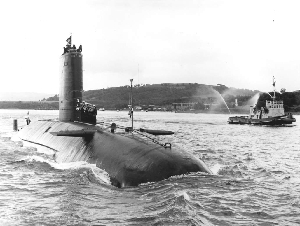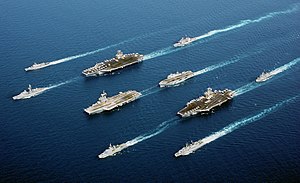
A cruiser is a type of warship. Modern cruisers are generally the largest ships in a fleet after aircraft carriers and amphibious assault ships, and can usually perform several operational roles from search-and-destroy to ocean escort to sea denial.

A carrier battle group (CVBG) is a naval fleet consisting of an aircraft carrier capital ship and its large number of escorts, together defining the group. The CV in CVBG is the United States Navy hull classification code for an aircraft carrier.

A naval ship is a military ship used by a navy. Naval ships are differentiated from civilian ships by construction and purpose. Generally, naval ships are damage resilient and armed with weapon systems, though armament on troop transports is light or non-existent.

Naval warfare is combat in and on the sea, the ocean, or any other battlespace involving a major body of water such as a large lake or wide river. Battles have been fought on water for more than 3,000 years.

A warship or combatant ship is a ship that is built and primarily intended for naval warfare. Usually they belong to the armed forces of a nation. As well as being armed, warships are designed to withstand damage and are typically faster and more maneuverable than merchant ships. Unlike a merchant ship, which carries cargo, a warship typically carries only weapons, ammunition and supplies for its crew. Warships usually belong to a navy, though they have also been operated by individuals, cooperatives and corporations.

HMS Conqueror was a British Churchill-class nuclear-powered fleet submarine which served in the Royal Navy from 1971 to 1990. She was the third submarine of her class, following the earlier Churchill and Courageous, that were all designed to face the Soviet threat at sea. She was built by Cammell Laird at Birkenhead.

PNS/M Hangor (S-131) was a Daphné-class diesel-electric submarine that served in the Pakistan Navy from 1969 until its decommissioning in 2006. It is the first submarine to sink a ship after World War II.

Surface warfare is naval warfare involving surface ships. It is one of the four operational areas of naval warfare, the others being underwater warfare, aerial warfare, and information warfare. Surface warfare is the oldest and most basic form of naval warfare, though modern surface warfare doctrine originated in the mid-20th century.
The names of commissioned ships of the United States Navy all start with USS, for United States Ship. Non-commissioned, primarily civilian-crewed vessels of the U.S. Navy under the Military Sealift Command have names that begin with USNS, standing for United States Naval Ship. A letter-based hull classification symbol is used to designate a vessel's type. The names of ships are selected by the Secretary of the Navy. The names are those of states, cities, towns, important persons, important locations, famous battles, fish, and ideals. Usually, different types of ships have names originated from different types of sources.

The Pakistan Navy (PN) is the uniform naval warfare branch of the Pakistan Armed Forces. The President of Pakistan is the Supreme Commander of the Navy. The Chief of the Naval Staff, a four-star admiral commands the navy. The Pakistan Navy operates on the coastline of Pakistan in the Arabian Sea and Gulf of Oman. It was established in August 1947, following the independence of Pakistan from the United Kingdom.

The Battle of the Mediterranean was the name given to the naval campaign fought in the Mediterranean Sea during World War II, from 10 June 1940 to 2 May 1945.

A missile boat or missile cutter is a small, fast warship armed with anti-ship missiles. Being smaller than other warships such as destroyers and frigates, missile boats are popular with nations interested in forming a navy at lower cost. They are similar in concept to the torpedo boats of World War II; in fact, the first missile boats were modified torpedo boats with the torpedo tubes replaced by missile tubes.

Operation Trident was an offensive operation launched by the Indian Navy on Pakistan's port city of Karachi during the Indo-Pakistani War of 1971. Operation Trident saw the first use of anti-ship missiles in combat in the region. The operation was conducted on the night of 4–5 December and inflicted heavy damage on Pakistani vessels and facilities. While India suffered no losses, Pakistan lost a minesweeper, a destroyer, a cargo vessel carrying ammunition, and fuel storage tanks in Karachi. Another destroyer was also badly damaged and eventually scrapped. India celebrates its Navy Day annually on 4 December to mark this operation. Trident was followed up by Operation Python three days later.
Operation Dwarka, codenamed as Operation Somnath, was a naval operation by the Pakistan Navy to attack the Indian coastal town of Dwarka on 7 and 8 September 1965. This instance was the first engagement by the Pakistan Navy in any of the Indo-Pakistan Wars.

Anti-submarine warfare is a branch of underwater warfare that uses surface warships, aircraft, submarines, or other platforms, to find, track, and deter, damage, or destroy enemy submarines. Such operations are typically carried out to protect friendly shipping and coastal facilities from submarine attacks and to overcome blockades.
The development of the steam ironclad firing explosive shells in the mid-19th century rendered sailing ship tactics obsolete.

Anti-surface warfare is the branch of naval warfare concerned with the suppression of surface combatants. More generally, it is any weapons, sensors, or operations intended to attack or limit the effectiveness of an adversary's surface ships. Before the adoption of the submarine and naval aviation, all naval warfare consisted of anti-surface warfare. The distinct concept of an anti-surface warfare capability emerged after World War II, and literature on the subject as a distinct discipline is inherently dominated by the dynamics of the Cold War.

The United States Navy (USN) is the maritime service branch of the United States Armed Forces and one of the eight uniformed services of the United States. It is the largest and most powerful navy in the world, with the estimated tonnage of its active battle fleet alone exceeding the next 13 navies combined, including 11 allies or partner nations of the U.S. as of 2009. It has the highest combined battle fleet tonnage and the world's largest aircraft carrier fleet, with 11 in service, 1 undergoing trials, two new carriers under construction, and six other carriers planned as of 2024. With 336,978 personnel on active duty and 101,583 in the Ready Reserve, the U.S. Navy is the third largest of the United States military service branches in terms of personnel. It has 299 deployable combat vessels and about 4,012 operational aircraft as of July 18, 2023.
The Indo-Pakistani Naval War of 1971 refers to the maritime military engagements between the Indian Navy and the Pakistan Navy during the Indo-Pakistani War of 1971. The series of naval operations began with the Indian Navy's exertion of pressure on Pakistan from the Indian Ocean, while the Indian Army and Indian Air Force moved in to choke Pakistani forces operating in East Pakistan on land. Indian naval operations comprised naval interdiction, air defence, ground support, and logistics missions.
At the beginning of World War II, the Royal Navy was the strongest navy in the world, with the largest number of warships built and with naval bases across the globe. It had over 15 battleships and battlecruisers, 7 aircraft carriers, 66 cruisers, 164 destroyers and 66 submarines. With a massive merchant navy, about a third of the world total, it also dominated shipping. The Royal Navy fought in every theatre from the Atlantic, Mediterranean, freezing Northern routes to Russia and the Pacific ocean.
















